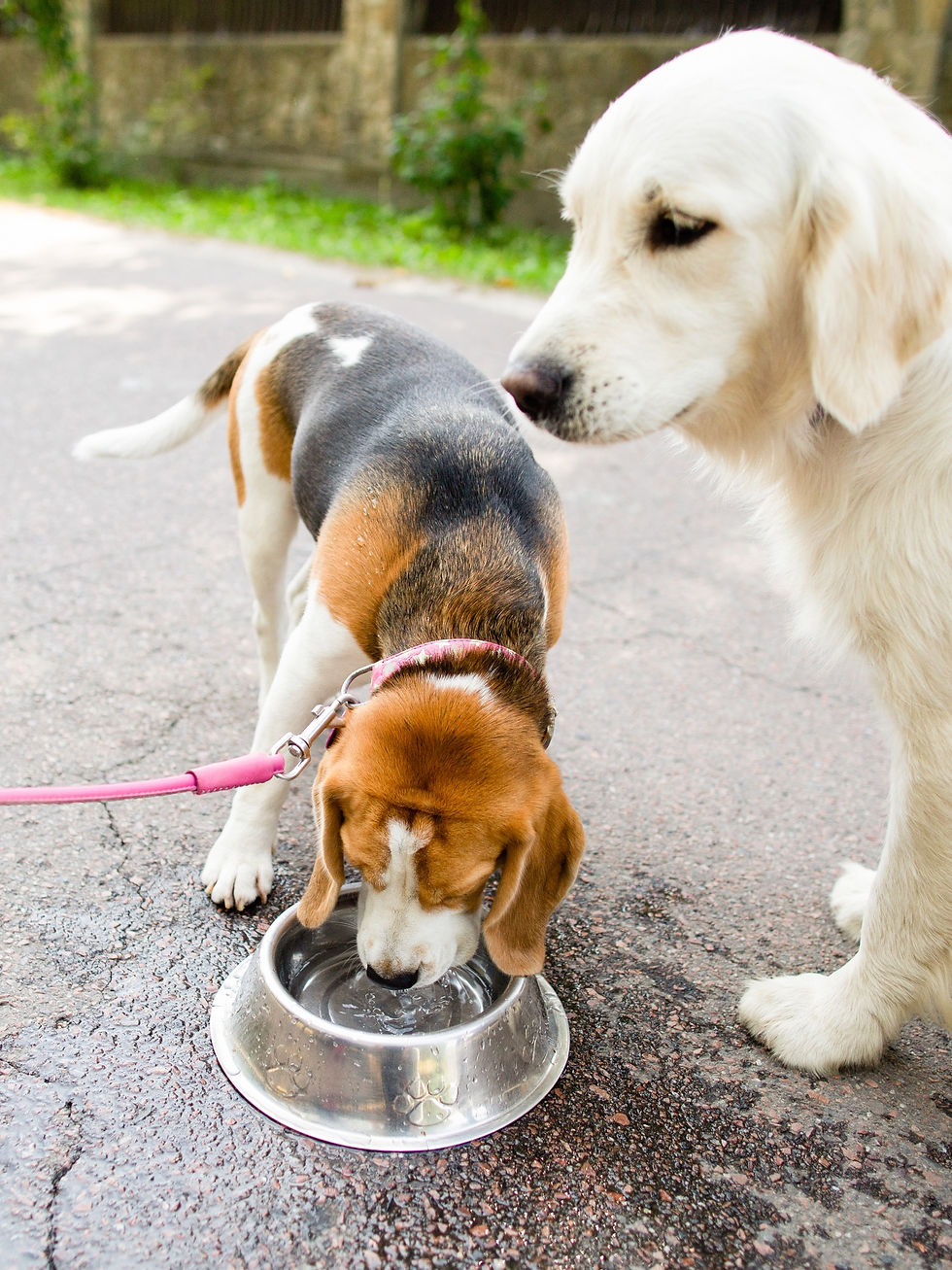Heatstroke in dogs: how to spot, avoid and treat
- Pets on tapp

- Jul 13, 2022
- 4 min read
This week, our Veterinarian friends from Pets on tapp™ help us highlight a big problem amongst dogs during the summer months - heat stroke!

Despite all the chaos that COVID-19 has brought us, we are still incredibly lucky to have easy access to beautiful hiking trails and remote beaches to enjoy the great outdoors with our dogs. However, when we share these amazing adventures with our furry friends we sometimes inadvertently put them at risk!
Heat stroke (also known as hyperthermia) is a condition caused by high body temperatures secondary to high external temperatures or excessive exercise in humid conditions. In Hong Kong we are faced with not only high summer temperatures, but also high humidity - a double whammy for humans and pets alike. The high humidity prevents rapid cooling via panting (which is one of the major ways a dog cools itself) increasing the chances of the pet being affected by heat stroke.
As with anything, if we know what to look out for we can take control of the situation sooner and hopefully have better outcomes for our pets.
What are the signs and symptoms of heat stroke?

Excessive panting
Drooling
Reddened gums
Restlessness
Vomiting
Diarrhoea
Dullness
Collapse
Seizuring
Pets at higher risk
Obese animals have a thicker layer of fat insulating them making it easier to over heat. Obesity also affects airways by increasing pressure on the lungs from the abdomen which can affect cooling via panting.

Pets suffering from airways disease such as tracheal collapse. As these pets start to pant their airways that are prone to collapsing start to narrow resulting in less air movement, the more they narrow the harder the pet tries to draw breath. The pet often starts to panic as they cant catch their breath causing severe respiratory distress. If allowed to continue unchecked the airways become inflamed and secretions get stuck causing an obstruction.
Snub nose (also known as brachycephalic) breeds e.g. french bulldogs, pugs. These dogs have a very abnormal upper respiratory tract where most of the heat is lost in dogs, they are prone to tracheal collapse and obesity… making them very inefficient at cooling themselves. These guys can get heat stroke even when being pushed in a trolley!!!

What should you do if you suspect your dog is suffering from heatstroke?
Take your pet to the nearest vet ASAP
Start cooling them:
Move the pet to a cooler environment - such as a shaded area or car with fan or air conditioning.
Apply tap water over their body, especially the hairless areas of armpits and groins, where large blood vessels are located
A fan allows for more rapid evaporation and is very effective at cooling
Offer drinking water in small volumes
Common Mistakes

Wanting to take your pet to ‘your’ family vet who is further away - This time wasted in a car, sometimes stuck in traffic is often a life vs death situation. The most important thing when exploring new parts of Hong Kong with your pet is to ensure you know where the closest veterinarian is located. Initial stabilization of the pet is vital and a pet can always be transferred to a 24-hour hospital later.
Using ice packs or ice cold water to cool a pet - These cause constriction of the blood vessels in the skin. When a pet experiences heat stroke the body tries to move hot blood from the core and the vital organs (heart and brain) to the periphery where it can escape via skin. It does this by dilating the blood vessels, a reason why the blood pressure drops in these patients. When we use water that is cooler than the body temperature, such as ice packs, we cause constriction of these peripheral blood vessels leading to a decrease in the ability to cool the core via the skin. This makes the situation worse.

Using wet towels to cool a pet - Many posts on Facebook mention using water soaked towels as a method to cool a pet. These are initially good options but as soon as they warm up and air becomes trapped between the towel and the pet’s body. Heat can no longer be exchanged and the towel just becomes an insulator making the situation worse.
Allowing a pet to drink water freely - When a pet is feeling the full effects of heat stroke there is a drive to drink large volumes of water which can lead to vomiting, increasing chances of aspiration pneumonia.

Top Tips to avoid Heat stroke
Always allow your pet access to a cool, shaded area on a hot day
Always have water available, and offer this frequently when out exercising with your dog
Walk your pet during cooler periods of the day such as early morning and evenings
Avoid extensive exercise on very hot days
Understand which pets are at higher risk, address these concerns with your veterinarian and see if there are solutions available to mitigate these risks (BOAS surgery for snub nose dogs, weight loss programmes for obese dogs, medications for tracheal collapse)
Consider carrying a small portable fan while hiking, incase of emergencies
Know where the closest vet is located (Pets on tapp PetConnect Website)

What happens once you are at the veterinary hospital?
The vet will examine the pet and start immediate emergency treatment to mitigate the effects of heat stroke. The initial focus is on cooling the pet, providing life saving fluid therapy, supplementing oxygen and getting baseline blood results.
Heat stroke is a challenging syndrome to treat as it causes havoc in the body with many problems only presenting multiple hours to days later which can require multiple medical interventions. Some of the more common issues are heart arrhythmias, seizures, gastric ulceration and clotting problems. Often multiple days in hospital are needed with very close intensive monitoring, which ultimately means a large vet bill!
Unfortunately, with heat stroke, no guarantees are EVER made and even after you think you are out of the woods another complication arises. Due to this, we believe PREVENTION is better than cure (as with most things) and educating yourself and all family members on what the signs of heatrokes are, which pets are at higher risk and how to avoid it, is essential!
A word from the author
A big hello to all the dogs and their owners who explore Hong Kong!
We are veterinarians from Pets on tapp™ and we hope to share some of our experiences as veterinarians (and pet owners) from Hong Kong. If you liked this article, please check us out on petsontapp.com and follow us on Facebook and Instagram for more updates.
Want to be a guest blogger too? Simply drop us an email at exploringdogs@gmail.com and pitch us your ideas!







Comments